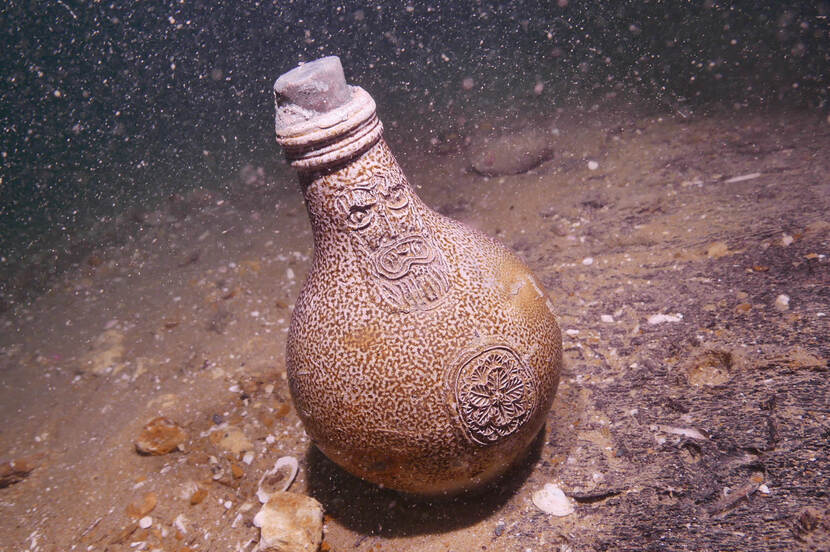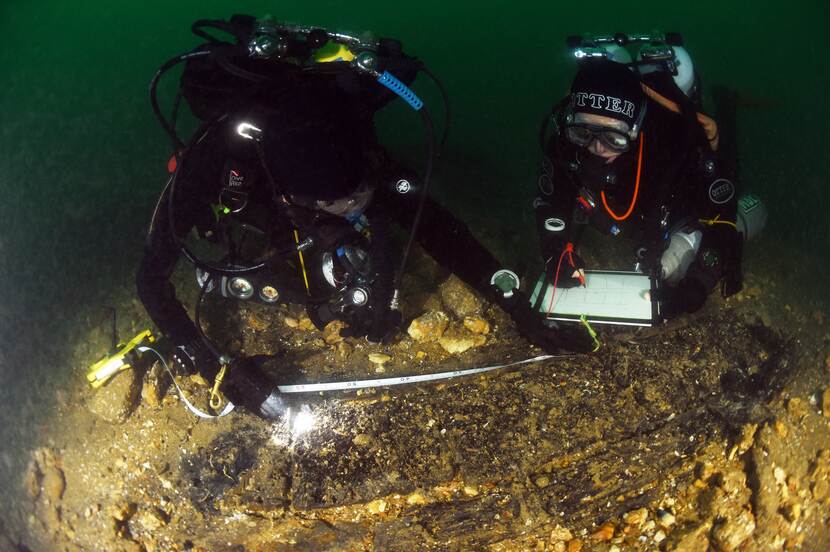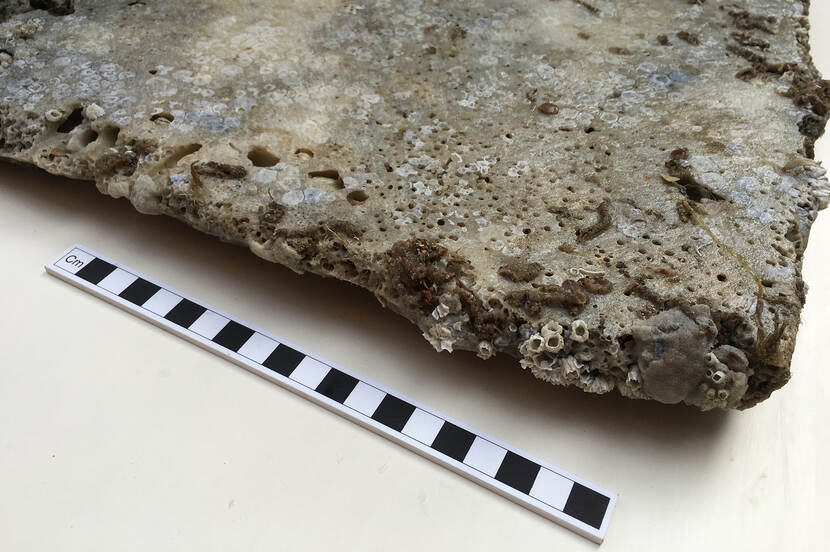Eastbourne-wreck is Dutch warship Klein Hollandia (1656-1672)
An unknown Protected Wreck off the coast of Sussex has been identified as the 17th century Dutch warship Klein Hollandia. Built in 1656 and owned by the Admiralty of Rotterdam, the ship was involved in all major battles in the second Anglo-Dutch war (1665-1667).
Over the past year, specialists from Historic England, Cultural Heritage Agency of the Netherlands (RCE) and the Nautical Archaeology Society (NAS) have been working on its identification through evidence gathered during dives of the wreck by a team of professional and volunteer divers, as well as through archival research and dendrochronological (tree ring) analysis of the wood samples. Until now, the wreck, which lies 32 metres under water on the seabed, was known as the ‘Unknown Wreck off Eastbourne’ – but it has now been identified as the Klein Hollandia (built 1656 – sank 1672).
[Tekst continues under the photo]

Italian marble and pottery
The condition of the wreck is remarkable and could offer a wealth of information about how 17th century Dutch ships were built and the activities of the warship during its final voyage. Material found on the seabed includes much of the wooden hull, cannons, Italian marble tiles and pieces of Italian pottery. The marble tiles came from the Apuan Alps quarries close to Carrara in Italy. They were conserved by Historic England archaeological conservators, prior to the investigations. The marble tiles were bound for the Netherlands and would have been used to build high-status homes.
Discovered in 2019, the Klein Hollandia was considered so important that it was granted the highest level of protection in the same year, under the Protection of Wrecks Act 1973. This year (2023) marks 50 years of the Act. Only licensed divers are allowed to dive to the wreck site. The wreck was discovered by Eastbourne dive operator David Ronnan and reported to Historic England. David Ronnan and Mark Beattie-Edwards from NAS are the licensees and have been investigating the wreck since its discovery.
Mark Beattie Edwards, CEO of the Nautical Archaeology Society said: From our very first dive on the wreck, back in April 2019, we have been fascinated by the range of material on the seabed. The impressive amount of wooden hull structure, the ships cannons, the beautifully cut marble tiles, as well as the pottery finds, all point towards this being a Dutch ship from the late 17th century coming back from Italy. Now, after four years of investigation and research, we can confidently identify the vessel
.
[Tekst continues under the photo]

International cooperation
Gunay Uslu, Dutch State Secretary for Culture and Media: With maritime archaeological and cultural-historical research into shipwrecks like the Klein Hollandia, stories as well as tangible remains come to the surface. This provides valuable knowledge and important insights in the shared history of our seafaring nations. What we’ve learned about this specific shipwreck, provides input for the general debate about our past and current issues in the present.
Without responsible management, wrecks like these will disappear. Therefore international collaboration with partners like the United Kingdom is important and highly appreciated; it helps us to actively preserve valuable maritime heritage for current and future generations
.
Heritage Minister Lord Parkinson of Whitley Bay said: The identification of the Klein Hollandia offers a glimpse back into the seventeenth century, giving us a chance to learn more about the maritime history of this period and to uncover treasures which have been underwater for hundreds of years.
I am very pleased that, thanks to this partnership between the UK and the Netherlands, we have been able to solve some of the mysteries linked to this wreck – and to protect it for future generations to continue to research.
The Dutch warship
The Klein Hollandia, owned by the Admiralty of Rotterdam, was involved in all major battles in the second Anglo-Dutch war (1665-1667). In 1672, the ship was part of the squadron of Admiral de Haese to escort the Smyrna fleet while sailing from the Mediterranean into the English Channel, en-route for the Netherlands. At the Isle of Wight, the squadron was attacked by an English squadron under Admiral Holmes. A fierce battle broke out on the second day, March 23, resulting in the Klein Hollandia being damaged severely. The commander of the ship, Jan Van Nes was killed in action. The ship was boarded and conquered by the English, but shortly after the Klein Hollandia sank with both English and Dutch sailors on board. This surprise action by the small squadron under Sir Robert Holmes and Sir Frecheville Holles contributed to the start of the Third Anglo-Dutch War. See mass.cultureelerfgoed.nl for more information.
[Tekst continues under the photo]

First discovery of the site
The wreck was first classified as an anomaly on the seabed during a hydrographic survey in 2015 by the UK Hydrographic Office. It wasn’t until 2019 that David Ronnan, a local dive operator working out of Eastbourne, confirmed the early indications of the survey and discovered a shipwreck. After reporting the discovery to Historic England, he and Mark Beattie-Edwards from NAS became the wreck licensees. Since 2019, staff and volunteer divers from the NAS have undertaken 282 dives on the site and have built up a comprehensive picture of what is on the seabed.
Identifying the wreck as a Dutch warship
In August 2020, all the clues were pointing towards the wreck being of Dutch origin, given the analysis of the finds and historical research conducted in the UK and the Netherlands. The RCE funded a survey by the NAS, including the recovery of two cut stone tiles for analysis by Historic England experts. Petrographic examination (the use of microscopes to examine rock), mineral composition and isotope analysis identified the stone as being marble from the Apuan Alps quarries close to Carrara, Italy, home to some of the finest marble in Italy.
[Tekst continues under the photo]

Site at risk
In 2021, damage to the site was documented by NAS divers, which led to a joint decision by the RCE and Historic England to support further investigation of the wreck. The three organisations are involved in a project to forensically mark the objects on the seabed. This is a new form of technology that makes objects traceable: a large step forward in the protection of vulnerable underwater archaeological sites.
Martijn Manders, Manager of RCE’s International Program for Maritime Heritage (2017-2021), said: An absolute privilege to dive the site! The identification process has been a great joint effort between our two countries and the collaboration still continues, so that we can learn more about this fascinating site in the coming years. This project marks again the close ties archaeologists and heritage agencies of the two countries have built up over the years.
Duncan Wilson, Chief Executive of Historic England said: Investigating this internationally-significant Protected Wreck site has been an excellent example of partnership working between Historic England, Cultural Heritage Agency of the Netherlands and the Nautical Archaeology Society. We’re delighted that Historic England’s material scientists have played a key part in solving the mystery of this shipwreck’s previously hidden identity. Uncovering the story of the warship Klein Hollandia opens up another fascinating chapter in the already rich, shared maritime history between the UK and the Netherlands.
Netherlands maritime heritage in British waters
This research is part of a larger campaign of fieldwork and maritime heritage projects in which the UK and the Netherlands closely collaborate to preserve their shared maritime heritage. Both countries endorse the importance of this mutual collaboration and intend to continue this by exchanging knowledge, conducting joint research and supporting conditions to preserve maritime heritage in the future. Previously Historic England and the RCE have collaborated on the investigation of the Rooswijk, a Dutch East India Company ship lost on the Goodwin Sands in 1740.